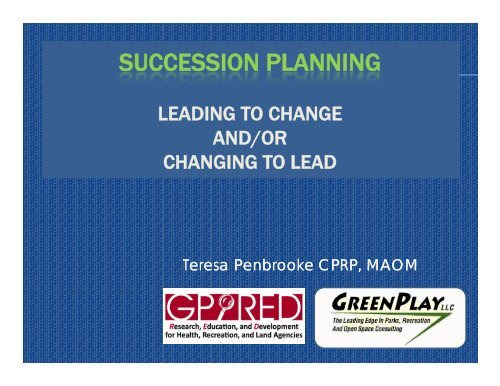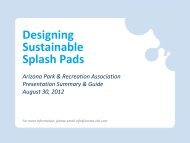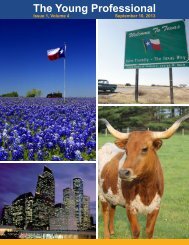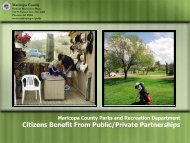SUCCESSION PLANNING
SUCCESSION PLANNING
SUCCESSION PLANNING
You also want an ePaper? Increase the reach of your titles
YUMPU automatically turns print PDFs into web optimized ePapers that Google loves.
<strong>SUCCESSION</strong> <strong>PLANNING</strong>LEADING TO CHANGEAND/ORCHANGING TO LEADTeresa Penbrooke CPRP, MAOM
8/30/2011TODAY’S GOALS1. Identify the challenges and outcomes thatcome with the exodus of key staff.2. Apply identification of necessary leadershipexpertise and skill sets to both trainingupcoming staff if you are leaving, and/or inyourself if you are the one hoping to become aleader.3. Create strategies, steps, and a plan foridentifying appropriate replacements andbuilding their capacity to lead.WHAT’S HAPPENING?Mass exodus and retirements30 – 50% in the next 5-10 yearsLower availability of trained staffAGING OF AMERICA• The first wave ofthe nation’s 76million babyboomers turn 65in 2011.• In 2008, 38.9million Americanswere ages 65and older. (13%)WHAT’S HAPPENING? Changing economicclimate Repositioning ofparks and recreationagencies Reactive orproactive?1
8/30/2011EXERCISE How do you develop leaders in your agency? How do you prepare for succession planningfor key leadership positions in your agency? How do you handle poor performers?WHAT DO WE NEED TO DO?4.6.3 Succession PlanningStandard: Agencies should formulate a successionplan to ensure the continued effectiveperformance of the organization by makingprovisions for the development and replacement ofkey people over time.<strong>SUCCESSION</strong> <strong>PLANNING</strong>Every organization has a uniquepopulation p of employees Often, the retiringemployees are inleadership positionsor possessinstitutionalknowledge critical toorganizationalsustainabilityAGENCY DEMOGRAPHICSBe aware of the agedemographics of theemployee workforce andplan for their inevitabledeparture.Agency demographicschange depending onagency lifecycle,community profile andmaturity.2
8/30/2011<strong>SUCCESSION</strong> <strong>PLANNING</strong> Succession planning should involve: leadership identificationifi i employee development leadership training knowledge transfer and legacy creation possible reorganization creation and communication of THE PLANCHANGE AND INNOVATION• Change can be scary• Risk adverse vs. risk takers• Develop a culture to support innovation…through recruitment, appraisal, and recognition• The change process - it is important• Involve employees to create alignment• Really good employees like working for a forwardthinking agencyDEVELOPING LEADERSCONSIDERATIONSFOR LEADERSHIPDEVELOPMENT A craft that you can continuously learnand adapt and become better Support continuing education Mentoring or Executive Coaching Performance Appraisal: 360 degrees Just in time feedback Build on strengths, not on weaknesses Job Rotations Read everything you can Create accountability3
8/30/20111. COMMUNICATIONPARKS AND RECREATION COREEXECUTIVE COMPETENCIESCERTIFIED PARKS AND RECREATION PROFESSIONAL (CPRP)CERTIFIED PARK AND RECREATION EXECUTIVE(CPRE) Foster good internal and external relationships Create marketing and communicationstrategies Communicate agency’s vision and mission Formalize collaborations and partnershipplanningKEYS TO RELEVANCE NOW“Align your department with solving publicproblems. That’s what repositioning is all about.”Dr. John L. CromptonDistinguished ProfessorTexas A&M University“Elected officials have some very tough choicesto make. It’s our job as recreation professionalsto provide them with information and tools to beable to make those decisions.”Ann Conklin,Director of Leisure ServicesCanton, MI4
8/30/20112. FINANCE Prepare and manage budgets for areas ofresponsibility Conduct cost recovery analysis for a specificarea Procure and manage traditional andalternative ti funding mechanismsFUNDING SOURCE ANALYSISStep 9: Select andimplement strategiesStep 8: Generateproblem-solvingstrategiesStep 7: Develop criteriafor successful strategiesStep 6: Identify appropriateindividuals/groups for theproblem-solving processStep 5: State the problems oropportunities to youth programmingStep 4: Identify the budget formatused in your departmentStep 3: Identify funding sourcesStep 2: Understand the management style ofdecision-making in your departmentStep 1: Define or clarify a strategic plan and mission for yourlocal parks and recreation departmentCORE SERVICES AND COST RECOVERYOTHER TOOLSTHE SERVICE ASSESSMENT1. Fit2. Program Attractiveness3. Alternative Coverage4. Competitive PositionCredit: Based on the MacMillan Matrix by Dr. Ian MacMillan –used for nonprofitstrategic planning5
8/30/2011OPERATIONS Compile adequate information to defend agency in theevent of accidents, risk management context Develop energy efficient and environmentally friendlyprocedures Analyze operating information and reports Plans to include participants with disabilities and allages and demographicsTrends ManagementWhat things have you seen in parks and recreationlately that you might not have seen 10 years ago?5. AGENCY <strong>PLANNING</strong> Best practices Agency strategic/master planning Identify needs for new facilities, services, and capitalimprovements Comprehensive program plan Collect public input (e.g., public hearings, focus groups,surveys)LEVEL OF SERVICE ANALYSISCapacities Analysis• Acreage per 1,000• Amenities• Quantitative analysisComposite ValuesMethodology (CVM)• Component Based• Qualitative analysis• Shows access7
8/30/2011PREVIOUS STANDARDS - CAPACITYActivity/FacilityRecommendedSpaceRequirementsServiceRadius andLocation NotesNumber ofUnits perPopulationBaseballOfficialLittle League3.0 to 3.85 acre minimum1.2 acre minimum¼ to ½ mileUnlighted part of neighborhood complex; lighted fields part ofcommunity complex1 per 5,000;lighted 1 per 30,000Basketball 2,400 – 3,036 vs.¼ to ½ mile1 per 5,000Youth5,040 – 7,280 s.f.Usually in school, recreation center or church facility; safe walkingHigh schoolor bide access; outdoor courts in neighborhood andcommunity parks, plus active recreation areas in other parksettingsFootball Minimum 1.5 acres 15 – 30 minute travel timeUsually part of sports complex in community park or adjacent toschool1 per 20,000Soccer 1.7 to 2.1 acres 1 to 2 milesYouth soccer on smaller fields adjacent to larger soccer fields orneighborhood parks1 per 10,000Softball 1.5 to 2.0 acres ¼ to ½ mileMay also be used for youth baseballTennisMinimum of 7,200 s.f. ¼ to ½ milesingle court area Best in groups of 2 to 4 courts; located in neighborhood community(2 acres perpark or near school sitecomplexVolleyball Minimum 4,000 s.f. ½ to 1 mileUsually in school, recreation center or church facility; safe walkingor bide access; outdoor courts in neighborhood andcommunity parks, plus active recreation areas in other parksettingsTotal landVarious types of parks - mini, neighborhood, community, regional,Acreageconservation, etc.1 per 5,000 (if also used for youthbaseball)1 court per 2,0001 court per 5,00010 acres per 1,000CURRENTBENCHMARKINGNPRA“PRORAGIS”679 Self‐reportingagencies ‐ mediansSpecializedComponent-BasedAnalysisFor Key IssuesAnd NeedsWHAT CAN YOU DO PERSONALLY? Volunteer Ask to be involved Share expertise Document institutional knowledge Create in-house transfer opportunities Identify mentors Write a Succession Plan8
8/30/2011<strong>SUCCESSION</strong> PLAN OUTLINE Intro / History Agency demographics Upcoming retirements / changes Leadership development support opportunities Recruitment and training strategies Plans for organizational change Strategic implementation steps Adopt and communicate the planQUESTIONS?THANK YOU FOR ATTENDING THIS<strong>SUCCESSION</strong> <strong>PLANNING</strong> PRESENTATION!EMAIL OR CALL WITH ANY QUESTIONS/SUGGESTIONS.Teresa Penbrooke, CPRP, MAOM, GP RED303-870-3884 TeresaP@GPRED.orgwww.GPRED.org www.GreenplayLLC.com9










